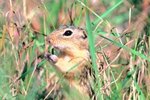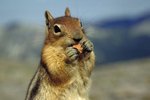
Squirrels are ubiquitous components of many terrestrial ecosystems; however, some species become seasonally dormant, and essentially disappear for months at a time. Because the nearly 280 living species exhibit great variation in body type, behavior and preferred habitat, few generalizations apply to the entire group. However, while some exceptions exist, most tree and flying squirrels remain active year-round, while many ground squirrels become dormant during extremely hot or cold weather.
Variation and Similarities Among Squirrels
Physically, squirrels fall into three different groups. Tree squirrels have long, lean bodies and big, bushy tails that improve their balance. Most flying squirrels -- who actually glide rather than fly -- are relatively small and have a thin membrane of skin stretching between their front and rear legs. Ground squirrels are the stoutest squirrels, and their short, compact bodies and strong forelimbs are well suited for digging tunnels. Some species -- particularly some ground squirrels -- are highly social and live in colonies, while others live primarily solitary lives. Squirrels are omnivores that occasionally consume small animals or eggs, but they primarily feed on vegetation. Favorite foods usually include items such as fruits, flowers, fungi, nuts and seeds.
Year-Round Activity
Year-round activity is common among tree squirrels. Despite cold winter temperatures, gray squirrels (Sciurus carolinensis) remain active -- and highly visible -- all year. However, these squirrels do take steps to help them survive the harsh conditions -- in addition to building up a thick layer of fat before the winter; squirrels can raise their body temperatures by shivering. During particularly bad weather, squirrels often limit their trips outside the nest and will huddle together with conspecifics to keep warm. Like gray squirrels, many other tree squirrels remain active all year, especially those species living in the tropics.
Facultative Activity
Some squirrels exhibit different adaptations to inclement weather, depending on their geographic range. Eastern chipmunks (Tamias striatus) inhabit a large portion of the eastern United States, and while they do not technically hibernate, most eastern chipmunks become dormant during the winter. However, they're only dormant for as long as is necessary -- dormancy may last many months for northern populations, but only a few weeks for southern populations. Regardless of their location, chipmunks may venture to the surface to forage on warm days, so they are occasionally observed on warm winter days. Other species adjust their activity patterns in unusual ways. Red giant flying squirrels (Petaurista petaurista) are native to a vast swath of south Asia, from Afghanistan to Indonesia. While these squirrels do not hibernate, they will migrate to climates that are more hospitable if food becomes scarce.
Deep Dormancy
Some squirrels inhabit areas with such extreme winter climates that hibernation is the only way they can survive. Arctic ground squirrels (Spermophilus parryii) living in Alaska are one such example, and they sometimes hibernate for up to eight months. To survive under such difficult conditions, arctic ground squirrels have developed their own method for hibernating. During their winter sleep, these squirrels allow their body temperatures to drop lower than any other living mammal -- sometimes below 32 degrees Fahrenheit. Occasionally, without waking, the squirrels begin shivering until their body temperatures approach 98 degrees Fahrenheit, at which time they stop shivering and their body temperatures fall again.
Surviving Summer
Some squirrels live in habitats with exceptionally hot and dry summers, such as the Mojave ground squirrel (Xerospermophilus mohavensis) of the southwest United States. To cope with these conditions, many squirrels exhibit a type of summer dormancy, known as estivation. During such times, the squirrels essentially go to sleep and wait for the temperatures to drop. Often, ground squirrels plug the entrance to their burrows with soil during estivation to provide some protection from predators.
References
- University of California: Agriculture and Natural Resources: Ground Squirrel
- National Park Service: Arctic Ground Squirrel
- Lincoln Park Zoo: What Do Squirrels Do in Winter?
- Animal Diversity Web: Sciuridae
- Animal Diversity Web: Petaurisa Petaurisa
- Animal Diversity Web: Tamias Striatus
- Animal Diversity Web: Spermophilus Armatus
- Arkive: Mohave Ground Squirrel (Xerospermophilus Mohavensis)
Photo Credits
-
Jupiterimages/Photos.com/Getty Images




